The Clark’s Grebe (Aechmophorus clarkii) is an elegant waterbird renowned for its striking appearance and graceful behavior.
This species belongs to the family Podicipedidae and is commonly found in freshwater lakes and ponds across western North America.
Recognizable by its sleek black and white plumage, the Clark’s Grebe is distinguished by a distinctive black cap that extends below the eye, contrasting with a white face and neck.
During the breeding season, these birds engage in elaborate courtship displays, involving synchronized movements and intricate postures on the water’s surface.
Their preferred habitats include large inland bodies of water, where they expertly dive for fish and aquatic invertebrates.
As superb swimmers and agile fliers, Clark’s Grebes are celebrated for their beauty and captivating behaviors, making them a cherished species among bird enthusiasts and wildlife observers.
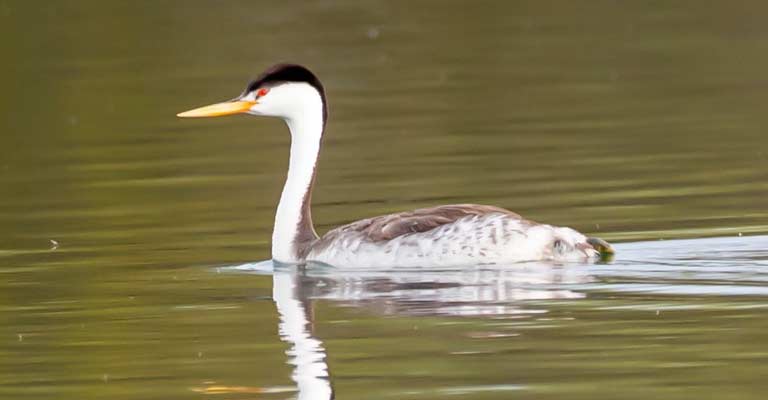
How to Identify Clark’s Grebe
Identifying Clark’s Grebe requires a keen eye and attention to distinct features that set it apart from other waterfowl. Here are eight key points to consider when identifying this elegant bird:
Distinctive Plumage
Clark’s Grebe showcases a striking black and white plumage that is characteristic of its species. The upper parts, including the head, neck, and back, are predominantly black, while the lower parts are primarily white.
A defining feature is the black cap on the head, extending below the eye and creating a distinctive contrast with the white face and neck.
Long, Slender Neck
One of the noticeable characteristics of Clark’s Grebe is its long, slender neck. This feature contributes to its graceful appearance, especially when engaging in courtship displays and various water maneuvers.
The neck is often extended during swimming and becomes a prominent aspect of its silhouette.
Red Eyes
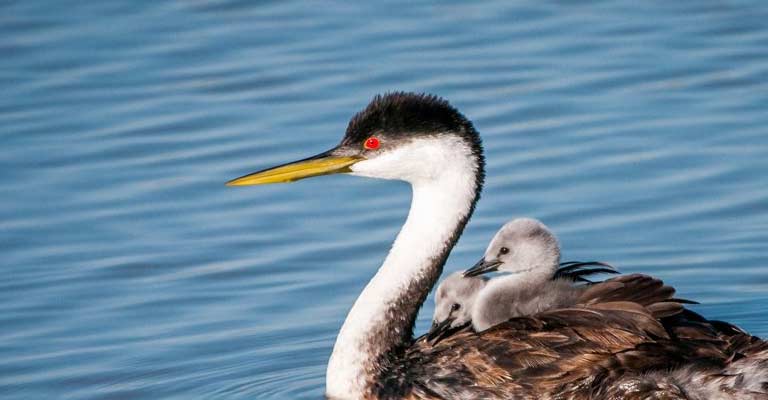
The eyes of Clark’s Grebe are a striking red, creating a vivid contrast against the black cap. This feature is particularly discernible during close observations and can aid in distinguishing this species from other grebes.
Size and Shape
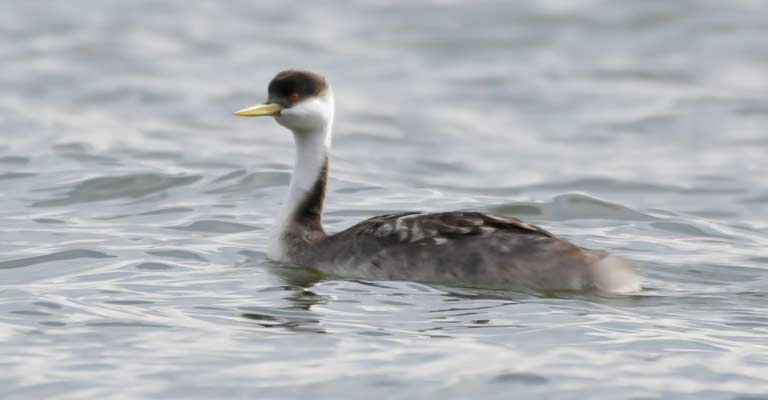
Clark’s Grebe is a relatively large grebe species with a sleek and streamlined body. Pay attention to its size in comparison to surrounding waterfowl, as well as its elongated shape.
This bird’s size, combined with its unique markings, helps set it apart from similar-looking species.
Bill Characteristics
Examining the bill is crucial for identification. Clark’s Grebe possesses a straight and slender bill, which is pointed at the tip.
The coloration of the bill is typically dark, complementing the overall dark plumage of the head and upperparts.
Breeding Plumage Distinctions
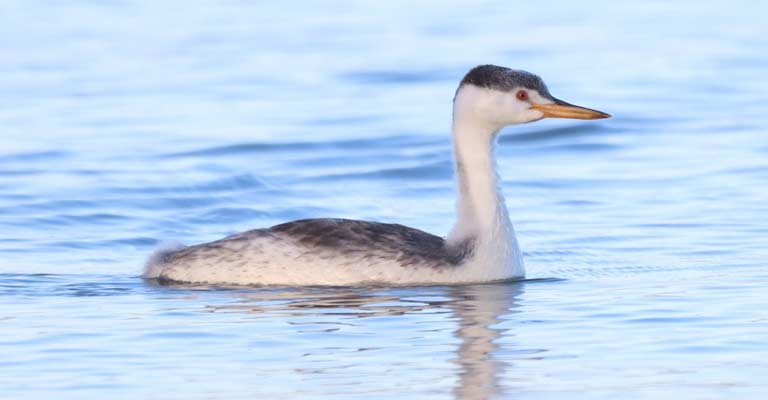
During the breeding season, Clark’s Grebe undergoes subtle changes in plumage. The black on the head intensifies, and the white areas become more vibrant.
Observing these seasonal variations can be key to accurate identification, especially if seen during the spring and summer months.
Behavioral Cues
Understanding the behavior of Clark’s Grebe is vital for identification. This species is known for its skilled swimming and diving abilities.
Watch for its elegant movements on the water’s surface, which often include synchronized swimming and elaborate courtship displays during the breeding season.
Identifying Clark’s Grebe involves a holistic approach, considering various physical features, behaviors, and environmental factors.
By combining these observations, bird enthusiasts can confidently recognize and appreciate the unique characteristics of this elegant waterbird.
Taxonomical Details of Clark’s Grebe
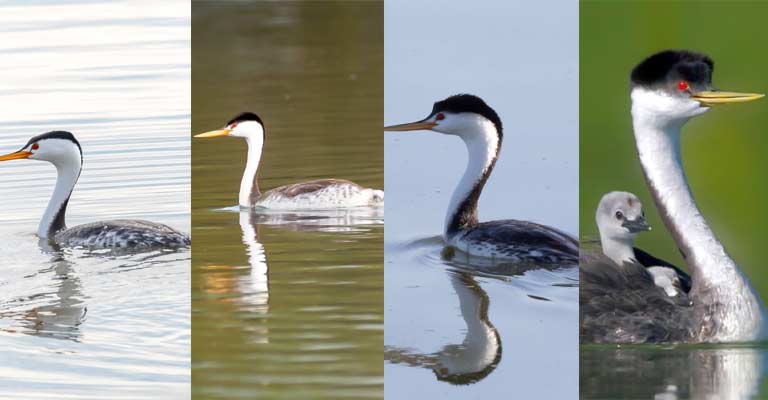
The following table will tell you everything about the taxonomy details of Clark’s Grebe:
| Taxonomic Rank | Classification |
| Domain | Eukaryota |
| Kingdom | Animalia |
| Phylum | Chordata |
| Class | Aves |
| Order | Podicipediformes |
| Family | Podicipedidae |
| Genus | Aechmophorus |
| Species | A. clarkii |
The Clark’s Grebe (Aechmophorus clarkii) exhibits subtle yet significant variations among its subspecies, contributing to the diverse tapestry of this waterbird species.
Two notable subspecies, A. c. ssp. clarkii (nominate) and A. c. ssp. transitionalis, display distinct characteristics, both in size and geographical distribution.
1. A. c. ssp. clarkii (Nominate)
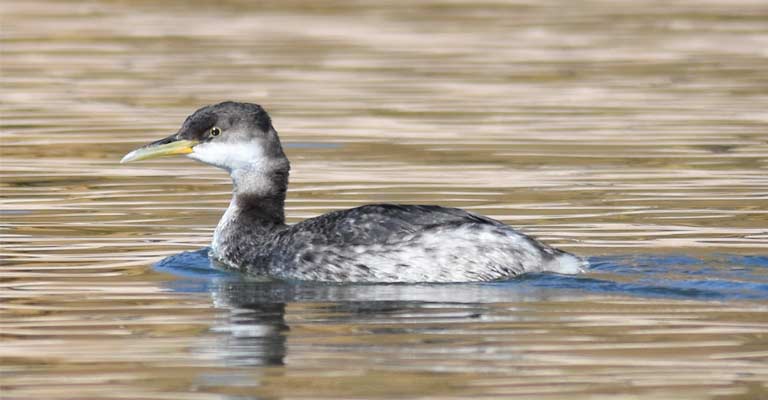
This subspecies, identified as the nominate clarkii, was first described by Lawrence in 1858. Notable for its relatively smaller size, it shares habitat ranges with the sympatric subspecies of Western Grebe (A. occidentalis ephemeralis) in north and central Mexico.
The nominate clarkii showcases the classic black and white plumage, with a prominent black cap extending below the eye, creating a visually striking contrast against the white face and neck.
While smaller in size compared to its transitionalis counterpart, the nominate clarkii retains the elegance and grace that characterize the species.
2. A. c. ssp. transitionalis
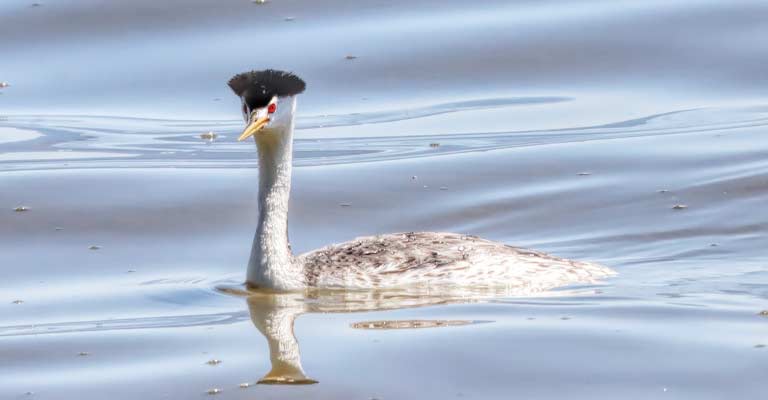
Described by Dickerman in 1986, the transitional subspecies of Clark’s Grebe is notably larger than the nominate clarkii.
This subspecies occupies a geographical range spanning western North America, extending from southeast Alaska down to northern Mexico. The larger size of A. c. ssp. transitionalis is a distinguishing feature, setting it apart from its smaller nominate counterpart.
While maintaining the iconic black and white plumage and the characteristic black cap, the transitional subspecies exhibit a grandeur befitting its larger frame.
Understanding these subspecies nuances provides valuable insights into the evolutionary adaptations and ecological preferences of Clark’s Grebe across its diverse habitats.
The subtle variations in size and geographic distribution highlight the dynamic nature of avian populations, reflecting the intricate interplay between genetics and environmental factors within the broader context of avian taxonomy and biodiversity.
Habitation and Range Map of Clark’s Grebe
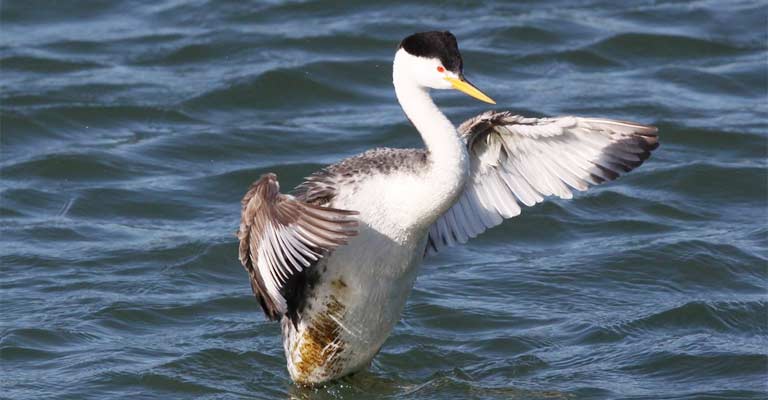
Clark’s Grebe (Aechmophorus clarkii) is a captivating waterbird known for its striking black and white plumage and graceful demeanor. Endemic to North America, this species exhibits distinct habitat preferences and a wide-ranging distribution.
Understanding its habitation and range is essential for appreciating the ecological dynamics that influence the life of Clark’s Grebe.
Geographic Range Map
Clark’s Grebe (Aechmophorus clarkii) is predominantly found in western North America, showcasing a vast and varied geographic range.
This elegant waterbird inhabits freshwater lakes, ponds, and reservoirs across a diverse landscape, spanning from the southern regions of Alaska down to northern Mexico.
Its distribution includes states along the western United States, such as California, Oregon, and Washington, and extending into western Canada.
The species is particularly prevalent in large inland bodies of water, where it engages in its characteristic swimming and diving behaviors.
Habitat Preferences
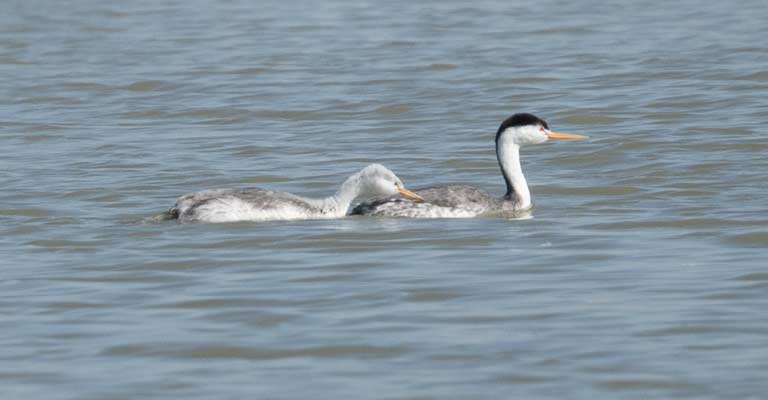
The habitation of Clark’s Grebe is closely tied to its affinity for freshwater environments. This species demonstrates a preference for open-water habitats, favoring expansive lakes and ponds with clear water.
These birds thrive in areas with abundant aquatic vegetation, providing both a source of food and potential nesting sites.
During the breeding season, Clark’s Grebes often engage in elaborate courtship displays on the water’s surface, showcasing their affinity for habitats conducive to these behaviors.
While their primary range encompasses western North America, the specific habitat choices within this range can vary, emphasizing the adaptability of Clark’s Grebe to diverse aquatic ecosystems.
Reproduction of Clark’s Grebe
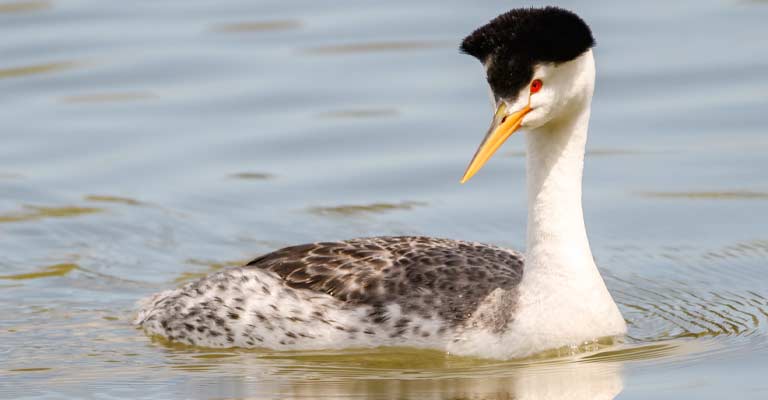
Clark’s Grebe engages in elaborate courtship displays as part of its reproductive behavior. During this intricate ritual, pairs perform synchronized movements on the water’s surface, showcasing their bond and reinforcing their connection.
The breeding season prompts the development of vibrant breeding plumage, with the black cap intensifying in color. Nesting occurs in colonies on floating platforms or emergent vegetation.
The female typically lays two eggs, and both parents actively participate in incubation. Once hatched, the chicks are precocial, capable of swimming and diving shortly after birth.
The family unit remains close-knit, with parents providing diligent care and guidance to ensure the fledglings’ successful transition to independence.
Clark’s Grebe Life History
The life history of Clark’s Grebe (Aechmophorus clarkii) is a fascinating journey shaped by its graceful existence in North America’s aquatic landscapes.
From its dietary preferences to nesting behaviors, susceptibility to diseases, conservation challenges, and subsequent treatment efforts, each phase contributes to the intricate tapestry of this waterbird’s life.
Food
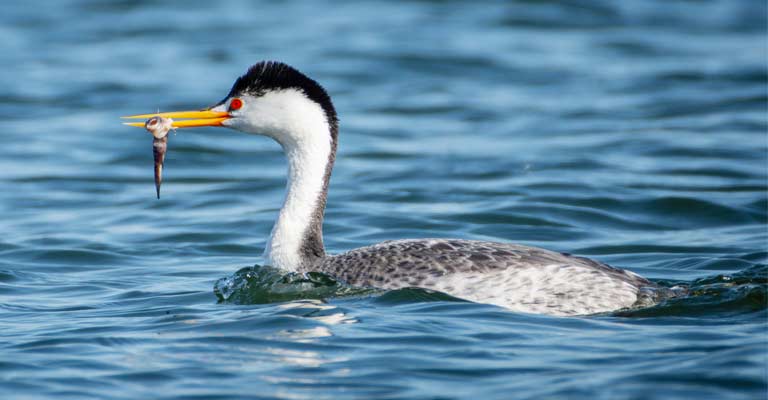
Clark’s Grebe sustains itself primarily on a diet of fish and aquatic invertebrates. With exceptional swimming and diving capabilities, it adeptly forages underwater, employing its long bill to catch prey.
This species thrives in freshwater environments, targeting areas rich in prey to meet its nutritional needs.
Nesting
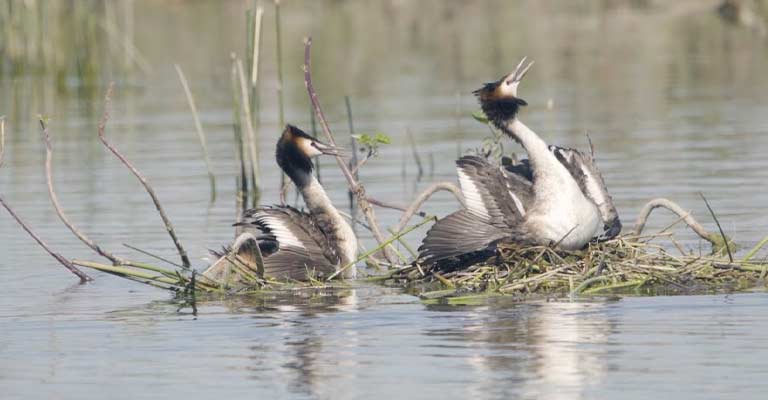
During the breeding season, Clark’s Grebe engages in elaborate courtship displays, showcasing synchronized movements and vibrant plumage. Nesting typically occurs in colonies on floating platforms or emergent vegetation.
The female lays a clutch of two eggs, and both parents actively participate in incubation, fostering a collaborative approach to nurturing the next generation.
Here’s a table summarizing nesting details of Clark’s Grebe:
| Nesting Details | Facts |
| Clutch Size | Typically two eggs |
| Number of Broods | Usually one per breeding season |
| Egg Length | Approximately 2.2 – 2.6 inches (5.6 – 6.6 cm) |
| Egg Width | Around 1.4 – 1.6 inches (3.6 – 4.1 cm) |
| Incubation Period | Approximately 22-24 days |
| Nestling Period | Chicks are precocial, capable of swimming and diving shortly after hatching |
| Egg Description | Smooth, oval-shaped with a white coloration |
| Nest Construction | Floating platforms or built on emergent vegetation in colonies |
| Incubation Responsibilities | Both males and females actively participate |
| Parental Care | Both parents provide care and guidance to the fledglings |
Diseases
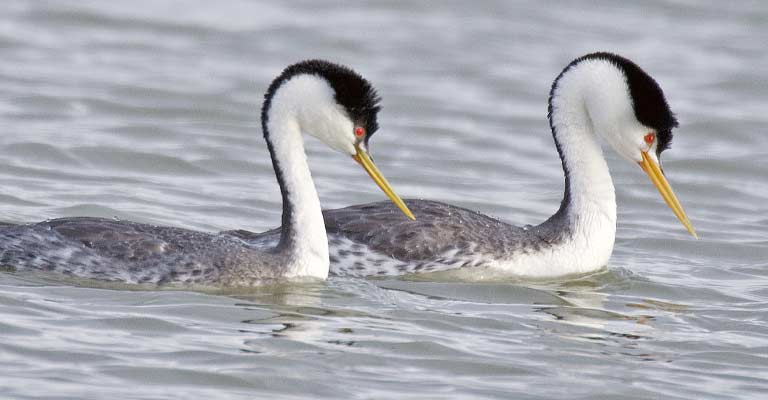
While resilient, Clark’s Grebe faces threats from various diseases that can impact its health and reproductive success.
Avian diseases, environmental contaminants, and habitat degradation pose challenges to populations, necessitating vigilant monitoring and conservation efforts.
Treatment
Addressing diseases in Clark’s Grebe involves a multifaceted approach. Wildlife health professionals may employ diagnostic tools to identify specific ailments, implementing treatment strategies such as medication, rehabilitation, and environmental mitigation.
Collaborative efforts between researchers, veterinarians, and conservationists play a crucial role in safeguarding the well-being of this species.
Conservation
Conservation initiatives for Clark’s Grebe focus on preserving and restoring critical habitats, monitoring populations, and implementing measures to mitigate threats.
Habitat protection, pollution control, and sustainable management of water resources contribute to the long-term conservation of this iconic waterbird.
Public awareness and education further support conservation efforts, fostering a shared responsibility for the welfare of Clark’s Grebe and its ecosystems.
5 Fun Facts About 0000
Clark’s Grebe (Aechmophorus clarkii) is an intriguing waterbird with unique characteristics that contribute to its charm and ecological significance. Here are five fun facts that shed light on the remarkable aspects of this avian species.
- Synchronized Courtship Displays: Clark’s Grebes engage in mesmerizing courtship displays, involving synchronized movements on the water’s surface. This intricate dance not only strengthens pair bonds but also showcases their remarkable coordination.
- Precocial Chicks: The chicks of Clark’s Grebe are precocial, meaning they are born with their eyes open, covered in down, and capable of swimming and diving shortly after hatching. This adaptation aids in their immediate survival in the aquatic habitats they call home.
- Elegant Plumage Changes: During the breeding season, Clark’s Grebe undergoes subtle but stunning plumage changes. The black cap intensifies in color, creating a more vibrant and striking appearance that contributes to their beauty.
- Floating Nest Platforms: Unlike some other grebe species, Clark’s Grebe is known for nesting on floating platforms or emergent vegetation in colonies. This behavior showcases their adaptability to diverse nesting environments.
- Vocalization and Communication: Clark’s Grebe communicates with a variety of vocalizations, including yodel-like calls. These vocal exchanges play a crucial role in establishing territories, coordinating during courtship, and maintaining communication within pairs.
Understanding these vocal cues adds another layer to the fascinating life of Clark’s Grebe.
Wrapping Up
Beyond its aesthetic appeal, Clark’s Grebe plays a vital role in the ecosystem, showcasing the delicate balance within aquatic environments.
As a sentinel species, the grebe’s presence signals the health of its habitat and the interconnected web of life it sustains. Conservation efforts become imperative to safeguard these remarkable birds and the habitats they inhabit.
Exploring the life history, nesting behaviors, and unique characteristics of Clark’s Grebe not only enriches our understanding of avian biodiversity but also reinforces the need for stewardship.
By appreciating and conserving the habitats that support this species, we contribute to the preservation of a natural heritage that extends far beyond the captivating surface of the water’s edge.
In protecting Clark’s Grebe, we safeguard a testament to the intricate beauty and resilience of our natural world.